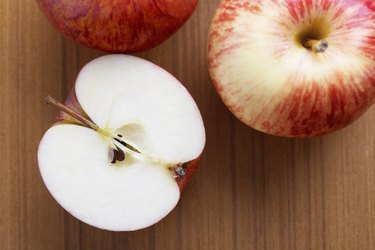
Have you seen mold on apples and other fruits in your fridge or cupboard? Then it's time to toss them. Like most fruits, apples can go bad and make you sick.
Tip
An apple that is firm and has no signs of mold or holes from insects should be safe to eat. Cut it in half before consumption and check the core for mold.
Video of the Day
What Causes Apples to Rot?
These juicy fruits have a long shelf life and can last for weeks. Sometimes, it can be hard to tell whether an apple is rotten or just overripe but still edible. First, make sure you understand what causes apples to go brown and rot.
Video of the Day
Many fruits, including apples, bananas, pears, plums, peaches and mangos, produce ethylene as part of the ripening process. This gas has a direct impact on their texture, flavor, nutritional value and other characteristics, according to a study featured in the April 2013 issue of the Journal of Experimental Botany.
Ethylene isn't the only factor responsible for fruit decay, though. Mold, oxidation, fungi, light, heat and humidity all play a role.
For example, when you cut an apple, the chemicals in its flesh are exposed to the oxygen in the air, which promotes the formation of polyphenol oxidase, an enzyme that causes the fruit to turn brown. This process is called oxidation.
Dangers of Mold on Apples
Microorganisms, such as fungi and mold, can affect apple shelf life, too. Warm and humid storage conditions, for instance, promotes mold growth. Some types of mold can develop in the refrigerator, which is why it's important to clean your fridge regularly and keep fresh or cut fruits covered in plastic wrap.
The USDA warns that mold may cause respiratory problems and allergies. Certain species produce harmful substances called mycotoxins. These compounds are often to blame for foodborne illnesses, impaired immune function and even cancer, states the World Health Organization.
More than 300 mycotoxins exist, each affecting different foods, according to a June 2017 review posted in the International Journal of Environmental Research and Public Health. Patulin, which is produced by the Penicillium expansum species, typically affects apples and their juice as well as other fruits, such as pears and grapes. When ingested in large amounts, it may cause nausea, ulcers, bleeding and even cancer.
Molds tend to grow on fruits and other high-acidic foods, according to the USDA. In general, moldy fruits have coin-size velvety circles on their skin. If you notice these signs, discard the apple in a way that children and animals cannot access it, for instance, by putting it in a paper bag or wrapping it in plastic, advises the USDA.
Refrain from sniffing the fruit, as you might inhale mold spores. This can lead to allergic reactions and respiratory issues.
Ideally, cut the apple in half and check its core before consumption. According to PennState Extension, some apples, especially Fuji, Golden Delicious and Red Delicious, may have a moldy core. Granny Smith apples are less prone to this issue. The mold doesn't always spread to the fruit flesh, though. In this case, it's still edible.
Know What to Look For
Brown spots inside an apple are not a reason for concern. As mentioned earlier, ethylene and exposure to oxygen may cause fruits to go brown. The apple is safe to eat as long as there are no signs of mold. However, it's best to avoid fruits with bruises, skin breaks and other signs of damage, as they are prone to mold.
If you purchase apples in a bag, check the expiration date. Make sure they have no signs of mold or holes caused by insects. Always buy these fruits before they're fully ripe. A healthy apple shouldn't be soft or leak juice.
Also, check your apples for dark circular lesions and sunken lesions that are light to dark brown. These are all signs of rot, according to Ohio State University Extension. The spots can extend quickly and cover the entire fruit as the rot progresses.
The American Heart Association recommends storing apples away from other produce. Since they release ethylene gas, they may cause other fruits and vegetables to rot. If you keep the apples in a refrigerator, they should last for at least one week. When stored on the countertop, they'll last for up to seven days.
Remember the old saying "One bad apple spoils the barrel?" As it turns out, it's true. That's why the USDA recommends wrapping apples separately to keep them fresh for longer. Wrap them in plastic or paper bags and store them either in the fridge or in a cool, dark place.
- Produce for Better Health Foundation: "About the Buzz: Certain Fruits and Vegetables Should Not Be Stored Together?"
- Journal of Experimental Botany: "Banana Ethylene Response Factors Are Involved in Fruit Ripening Through Their Interactions With Ethylene Biosynthesis Genes"
- Bosal Journals: "Extraction of Polyphenol Oxidase From Green and Red Apple Fruits and the Effect of pH Variation on the Activity of the Enzyme"
- USDA: "Molds on Food: Are They Dangerous?"
- World Health Organization: "Mycotoxins"
- Pennsylvania State University: "Moldy Core of Apple"
- Pennsylvania State University: "Apple Diseases - Fruit Rots, Control at Apple Harvest (and Postharvest)"
- Ohio State University: "Bitter Rot of Apple"
- American Heart Association: "Keep Fruits and Vegetables Fresher Longer"
- International Journal of Environmental Research and Public Health: "Occurrence, Toxicity, and Analysis of Major Mycotoxins in Food"